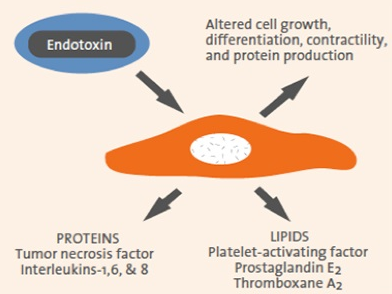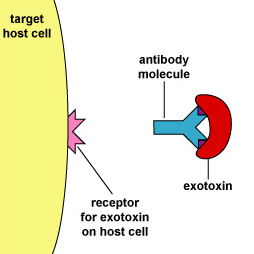What is an Endotoxin?
Endotoxin also known as lipoglycans is a toxic heat-stable lipopolysaccharide substance present in the outer membrane of gram-negative bacteria that is released from the cell upon lysis. Endotoxins are not secreted but are released only when the cells are disrupted, they are less potent and less specific than the exotoxins and do not form toxoids. If produced in large quantities they cause hemorrhagic shock and severe diarrhea. When produced in small quantities they cause fever, altered resistance to bacterial infection, leucopenia, leukocytosis and numerous other biological effects.
Some examples of bacteria that produce endotoxins are:
- Bacillus thuringiensis
- Neiserria gonorrhea
- Escherichia coli
- Haemophilus influenza.

What You Need To Know About Endotoxin
- Endotoxins are also known as lipopolysacharides of gram bacteria and can be defined as heat stable components of the gram-negative bacteria cell wall. Higher doses of these toxins are capable of inducing fever
- Endotoxins are basically the outer cell wall of gram-negative bacterium therefore they are Lipopolysaccharides (LPS)
- A large amount of endotoxins is needed to causes a disease and thus, their potency is not very high
- Endotoxins usually do not denature at 100 degrees Celsius for an hour and are said to be heat-stable
- Some examples of bacteria that produce endotoxins are bacillus thuringiensis, Neiserria gonorrhea, Escherichia coli and Haemophilus influenza
- Endotoxins are detected by Limulus lysate assay test
- Endotoxins show weak immunogenicity since they do not produce antitoxins
- Endotoxins taxoids cannot be made and there are no vaccines available
- Endotoxins contain catalase, Fibrolysin, IgA/IgG proteases
- Endotoxins are relatively not very specific in nature when compared to exotoxins
- Endotoxins are usually a component of the cell wall of gram-negative bacteria and are not secreted outside the cell. Although, little amounts of these toxins are being produced by the living organisms, amounts significant enough to cause a disease
- The genes for the production of endotoxins are located on bacterial chromosome
- Endotoxins mediate toxicity in the host through interleukins and Tumor Necrosis factor
- Diseases caused by endotoxins include meningococcal meningitis, coronary artery disease, meningococcaemia, gram negative bacterial sepsis, haemorrhagic shock, cystic fibrosis and typhoid fever
- Endotoxins are specific to certain bacterial strain and usually bind to specific receptors on cells
- Endotoxins are composed of three basic components O-antigen, Core oligosaccharide and lipid A
- Endotoxins usually do not induce fever in the host
- Endotoxins are generally not secreted or released outside the cell until death of cell
- Endotoxins do not have any affinity towards specific tissues
- Cell lysis is required for the release of endotoxins
What is an Exotoxin?
Exotoxins are heat labile proteins that are secreted by some species of bacteria and diffuse readily into the surrounding medium. They are highly potent and cause damage to the host by destroying cells or disrupting normal cellular metabolism. Streptococcal pyrogenic is a good example of an exotoxin existing in several antigenic types and causing fever, the rash of scarlet fever, organ damage, increased blood-brain barrier permeability and alterations in immune response.
Some examples of bacteria that produce exotoxins include:
- Shingella dysenteriae
- Vibro cholera
- Bordetella pertussis.

What You Need To Know About Exotoxin
- Exotoxins are soluble protein secreted by a bacterium which is capable of disrupting normal biological functioning of the host cell and evoking an immune response even in minute quantities
- Exotoxins on the other hand, are enzymes produced by bacteria and hence these molecules are proteins
- A single exotoxin molecule can act on a large number of host cells, therefore very little amount is needed to cause a diseases and thus their potency is very high
- Exotoxins usually denature at temperatures above 60 degrees Celsius and are said to be heat-liable
- Some examples of bacteria that produce exotoxins include Shingella dysenteriae , Vibro cholera and Bordetella pertussis
- Exotoxins are detected by many tests including precipitation, neutralization and ELISA-based methods
- Exotoxins are extremely immunogenic, and they trigger the humoral responsiveness. By stimulation of the immune system, exotoxins secrete antitoxins to neutralize the toxin
- Exotoxins, taxoids can be made by treating with formaldehyde but treated toxins show immunogenicity. Taxoids can be used as vaccines
- Exotoxins contain Hyaluronidase, Collagenase, and certain protease, Nuclease, Neuraminidase and Phospholipase A
- Exotoxins are relatively very specific in nature when compared to endotoxins. Exotoxins are enzymes, a factor that makes them highly specific in their mechanism and for their host cells
- Exotoxins are secreted out of the cell by number of gram-positive as well as gram-negative bacteria. These toxins are specifically produced to disrupt the normal functioning of the host cell or to facilitate the spread of organism through the host tissues
- The genes for the production of exotoxins are located on plasmids of bacteriophage genome
- Exotoxins mediate toxicity in the host by mostly enzyme-like mechanism
- Diseases causes by exotoxins include tetanus, diphtheria, botulism, scalded skin syndrome, scarlet fever and gas gangrene
- Exotoxins are not specific to any bacterial strain. Their specific receptors are not found in the cells
- Exotoxins are usually composed of two subunits A and B. A subunit is seen to have catalytic activity, whereas subunit B is required for binding with an appropriate cell receptor
- Exotoxins usually induce fever in the host by releasing mediators
- Exotoxins are secreted out of the cell
- Exotoxins show affinity towards specific tissues of host
- Cell lysis is not required for the release of exotoxins
Differences Between Endotoxins And Exotoxins In Tabular Form
| Basis Of Comparison | Endotoxin | Exotoxin |
| Definition | Endotoxins can be defined as heat stable components of the gram-negative bacteria cell wall. Higher doses of these toxins are capable of inducing fever. | Exotoxins are soluble protein secreted by a bacterium which is capable of disrupting normal biological functioning of the host cell and evoking an immune response even in minute quantities. |
| Chemical Nature | Endotoxins are basically the outer cell wall of gram-negative bacterium therefore they are Lipopolysaccharides (LPS). | Exotoxins are enzymes produced by bacteria and hence these molecules are proteins. |
| Potency | A large amount of endotoxins is needed to causes a disease and thus, their potency is not very high. | A single exotoxin molecule can act on a large number of host cells, therefore very little amount is needed to cause a diseases and thus their potency is very high. |
| Heat Stability | Usually do not denature at 100 degrees Celsius for an hour and are said to be heat-stable. | Usually denature at temperatures above 60 degrees Celsius and are said to be heat-liable. |
| Example of Bacteria that Produce Them | Some examples of bacteria that produce endotoxins are bacillus thuringiensis, Neiserria gonorrhea, Escherichia coli and Haemophilus influenza. | Some examples of bacteria that produce exotoxins include Shingella dysenteriae , Vibro cholera and Bordetella pertussis. |
| Detection Test | They are detected by Limulus lysate assay test. | They are detected by many tests including precipitation, neutralization and ELISA-based methods. |
| Immunogenicity | Show weak immunogenicity, they do not produce antitoxins. | They are extremely immunogenic, and they trigger the humoral responsiveness. By stimulation of the immune system, exotoxins secrete antitoxins to neutralize the toxin. |
| Toxoid potential | Endotoxins taxoids cannot be made and there are no vaccines available. | Exotoxins, taxoids can be made by treating with formaldehyde but treated toxins show immunogenicity. Taxoids can be used as vaccines. |
| Specificity | They are relatively not very specific in nature. | They are enzymes, a factor that makes them highly specific in their mechanism and for their host cells. |
| Enzymes | Endotoxins contain catalase, Fibrolysin, IgA/IgG proteases. | Exotoxins contain Hyaluronidase, Collagenase, and Certain protease, Nuclease, Neuraminidase and Phospholipase A. |
| Source | They are usually a component of the cell wall of gram-negative bacteria and are not secreted outside the cell. | Exotoxins are secreted out of the cell by number of gram-positive as well as gram-negative bacteria. |
| Genes | The genes for the production of endotoxins are located on bacterial chromosome. | The genes for the production of exotoxins are located on plasmids of bacteriophage genome. |
| How they mediate Toxicity | Mediate toxicity in the host through interleukins and Tumor Necrosis factor. | Mediate toxicity in the host by mostly enzyme-like mechanism. |
| Diseases | Diseases caused by endotoxins include meningococcal meningitis, coronary artery disease, meningococcaemia, gram negative bacterial sepsis, haemorrhagic shock, cystic fibrosis and typhoid fever. | Diseases causes by exotoxins include tetanus, diphtheria, botulism, scalded skin syndrome, scarlet fever and gas gangrene. |
| Specificity to Bacteria Strain | They are specific to certain bacterial strain and usually bind to specific receptors on cells. | They are not specific to any bacterial strain. Their specific receptors are not found in the cells. |
| Structure | They are composed of three basic components O-antigen, Core oligosaccharide and lipid A. | They are usually composed of two subunits A and B. A subunit is seen to have catalytic activity, whereas subunit B is required for binding with an appropriate cell receptor. |
| Fever Induction | Usually do not induce fever in the host. | Usually induce fever in the host by releasing mediators. |
| Cell Lysis | Cell lysis is required for the release of endotoxins. | Cell lysis is not required for the release of exotoxins. |
| Secretion | They are generally not secreted or released outside the cell until death of cell. | They are secreted out of the cell. |
| Affinity towards Host Tissue | They do not have any affinity towards specific tissues | Show affinity towards specific tissues of host. |
Summary
What is the main difference between endotoxins and exotoxins?
Endotoxins are heat stable components of the gram-negative bacteria cell wall. Higher doses of these toxins are capable of inducing fever. In contrast, Exotoxins are soluble protein secreted by a bacterium which is capable of disrupting normal biological functioning of the host cell and evoking an immune response even in minute quantities.

I am a student of microbiology at University of South Carolina, this is for sure a fantastic write up.
Now, please help understand this…
Why is exotoxin highly antigenic and endotoxins weakly immunogenic since the molecular weight of endotoxins(50-1000kDa) is greater than that of exotoxins(10kDa)?
I am a master student of microbiology at Stanford University. Could you please help me find the answers of the two questions below:
1-Are there any bacterial toxins that are not secreted out and are kept within the cell?
2-Are there any lipid toxins?